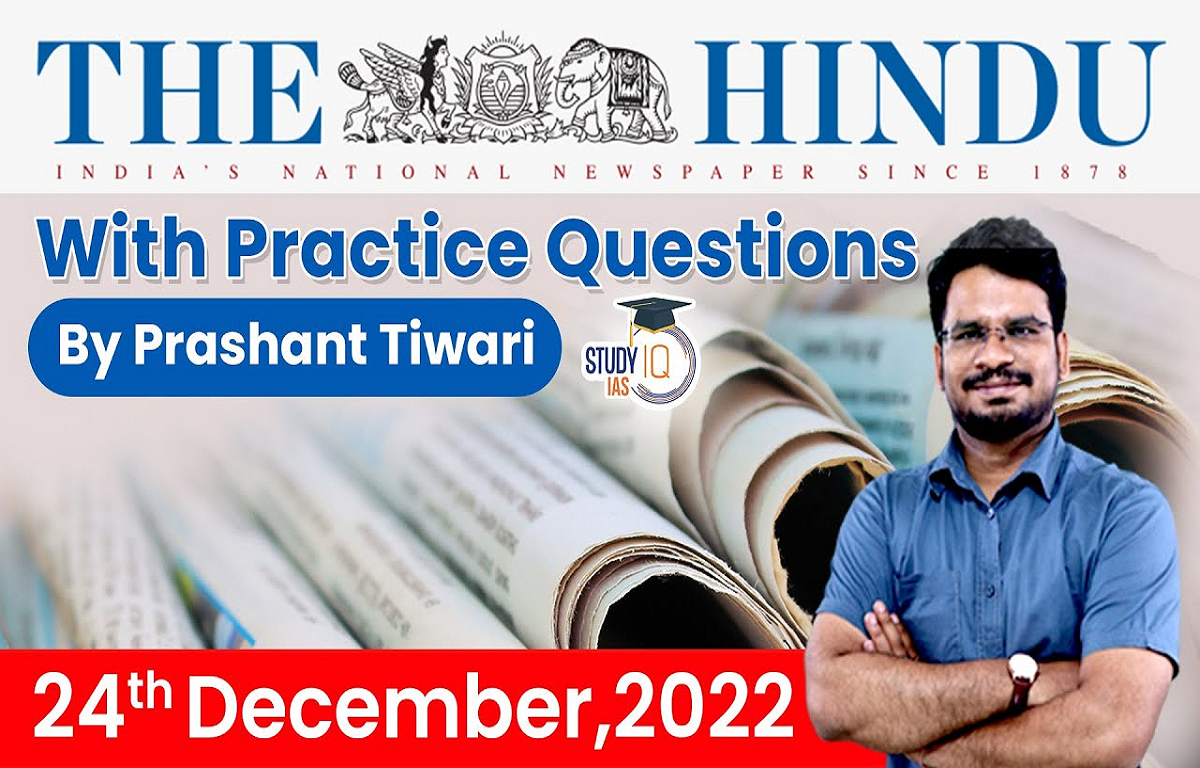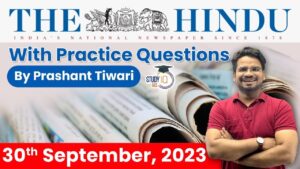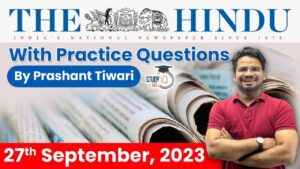The Hindu Newspaper Analysis for UPSC

The Hindu Newspaper Analysis 23 December 2022
- The Union Cabinet on Friday decided to provide free foodgrains to all 81 crore beneficiaries covered under the National Food Security Act (NFSA) for one year.
- The beneficiary families which used to pay ₹1 for coarse cereals, ₹2 for wheat and ₹3 for rice per kilogram will now get 35 kg of foodgrains a month free of cost for the next one year, and others will get five kilogram free each month till December 2023.
- PMGKAY is a part of Pradhan Mantri Garib Kalyan Package (PMGKP) to help the poor fight the battle against Covid-19.
- Its nodal Ministry is the Ministry of Finance.
- It was initially announced for a three-month period (April, May and June 2020), covering 80 crore ration cardholders. Later it was extended till November 2020.
- However, in April 2021, the government had announced its decision to restart the scheme as PMGKAY-III.
The Hindu Editorial Today
The salient features of the scheme are:
- 80 crore individuals, i.e, roughly two-thirds of India’s population would be covered under this scheme.
- Insurance cover of Rs 50 Lakh per health worker fighting COVID-19 to be provided under Insurance Scheme.
- 80 crore poor people will to get 5 kg wheat or rice and 1 kg of preferred pulses for free every month for the next three months.
- 20 crore women Jan Dhan account holders to get Rs 500 per month for next three months.
- Increase in MNREGA wage to Rs 202 a day from Rs 182 to benefit 13.62 crore families.
- Government to front-load Rs 2,000 paid to farmers in first week of April under existing PM Kisan Yojana to benefit 8.7 crore farmers.
National Food Security Act (NFSA), 2013
About:
- It was enacted in 2013.
- It gives legal entitlement to 67% of the population (75% in rural areas and 50% in urban areas) to receive highly subsidized foodgrains.
- Under the Targeted Public Distribution System (TPDS), foodgrain is sold at highly subsidized prices of Rs. 1/-, Rs. 2/- and Rs. 3/- per kg for nutri-cereals, wheat and rice respectively.
Ministry:
- The Department of Food and Public Distribution under the Ministry of Consumer Affairs, Food & Public Distribution is the nodal ministry for implementing this Act.
Eligibility:
- Under sub-section (1) of Section 3 of the Act, the term “eligible households” comprises two categories
- Priority household category is entitled to 5 kg per person per month.
- Antyodaya Anna Yojana (AAY) families are entitled to 35 kg per family per month.

- With unmanned aerial vehicles (UAV) or drones emerging as a powerful tool in the agricultural sector, a progressive farmer in Kerala’s Wayanad has trained himself in the technology for use in his plantation as well as to train officials of various government agencies.
- P. Chandrasekharan, an engineer turned farmer at Muttil in the district, has been using the technology on his farm and trained the officials for the past year after completing a six-month online course on ‘Drones for Agriculture’ from the Wageningen University and Research, The Netherlands.

- India ranks poorly on multiple health financing indicators. Its public health expenditure as a percentage of its GDP (1.28%) and share of general government expenditure dedicated to health (4.8%) remain akin to the poorest countries. Per capita health spending growth has not kept pace with rising incomes. Private spending still constitutes nearly 60% of overall expenditure on health.
- The private sector in India is inexorably dispersed, with marked inequities between rural and urban areas and widespread market failure.
- In such a scenario, initiatives that seek to make private healthcare more affordable without affecting care quality assume importance. This is likely to encompass a wide range of policy instruments that alter the operating conditions of the private sector.
- Moreover, such policies have to be enshrined in our national health policy. This should not be confused with driving public funds into public-private partnerships. Rather, we need overarching policies that drive down private healthcare costs even for the self-paying consumer with little or no government subsidy.

- India has taken up the fight against cervical cancer in earnest with the Central government announcing that it will roll out vaccination for girls aged between 9 and 14 years through schools.
- The decision comes at a critical juncture with a study in The Lancet published this month showing that India accounts for the highest number of cervical cancer cases in Asia, followed by China.
- Cervical cancer is a preventable and treatable cancer. It is caused by infection with the human papillomavirus (HPV) and there are vaccines which protect against carcinogenic HPV.
- To that end, the government’s intent to introduce the HPV vaccine in the Universal Immunisation Programme (UIP) is a welcome move.

- The UIP is one of the largest public health programmes targeting over 2 crore newborns and 2 crore pregnant women annually, and offers free vaccines for at least 12 diseases. To battle cervical cancer, India is expected to roll out the indigenously developed Cervavac vaccine by mid-2023.
- The vaccination will be provided primarily through schools, but importantly the government has clarified that girls who do not go to school will be reached through community outreach and mobile teams.
What is Cervical Cancer?
- Cervical cancer develops in a woman’s cervix. It is the 4th most common type of cancer among women, globally and 2nd most common among women in India.
- India contributes the largest share of the global cervical cancer burden; nearly 1 in every 4 deaths globally due to cervical cancer (as per The Lancet study).
- Almost all cervical cancer cases (99%) are linked to infection with high-risk HPV, an extremely common virus transmitted through sexual contact.


What’s this One Country Two Systems approach?
- As per the policy, the Hong Kong and Macau Special Administrative Regions, both former colonies, can have different economic and political systems from that of mainland China, while being part of the People’s Republic of China.
- It was proposed by Deng Xiaoping with an aim to unify China and Taiwan.
- On December 19, 1984, China and the U.K. signed the Sino-British Joint Declaration in Beijing, which set the terms for the autonomy and the legal, economic and governmental systems for Hong Kong post 1997.
- Similarly, on March 26, 1987, China and Portugal signed the Joint Declaration on the Question of Macau in which China made similar promises for the region of Macau after it was handed over to Beijing.
- Hong Kong returned to Chinese control on July 1, 1997, and Macau’s sovereignty was transferred on December 20, 1999.
- Both regions became Special Administrative Regions of China. The regions would have their own currencies, economic and legal systems, but defence and diplomacy would be decided by Beijing.
- Their mini-Constitutions would remain valid for 50 years — till 2047 for Hong Kong and 2049 for Macau. It is unclear what will happen after this term.
Q) With reference to the SAMARTH Scheme, consider the following statements:
- It promotes skill upgradation in the traditional sectors of handlooms.
- Ministry of Skill Development and Entrepreneurship is implementing Samarth Scheme.
Which of the above statements is/are correct?
- 1 only
- 2 only
- Both 1 and 2
- Neither 1 nor 2
समर्थ योजना के संदर्भ में निम्नलिखित कथनों पर विचार कीजिये:
- यह हथकरघा के पारंपरिक क्षेत्रों में कौशल उन्नयन को बढ़ावा देता है।
- कौशल विकास और उद्यमिता मंत्रालय समर्थ योजना लागू कर रहा है।
उपरोक्त कथनों में से कौन-सा/से सही है/हैं?
- केवल 1
- केवल 2
- 1 और 2 दोनों
- न तो 1 और न ही 2
Explanation :
- Recently, the Centre stated that under SAMARTH scheme, more than 13,235 artisans have been trained in the last three years.
- Government of India launched the “Scheme for Capacity Building in Textile Sector (SCBTS)” which is called SAMARTH, for the entire value chain of textiles except Spinning and Weaving in the organized sector, for a period of three years from 2017-18 to 2019-20.
Objectives
- To provide demand-driven, placement-oriented National Skills Qualifications Framework (NSQF) compliant skilling programmes to incentivize and supplement the efforts of the industry in creating jobs in the organized textile and related sectors, covering the entire value chain of textile, excluding Spinning and Weaving.
- To promote skilling and skill upgradation in the traditional sectors of handlooms, handicrafts, sericulture and jute.
- To enable the provision of sustainable livelihood either by wage or self-employment to all sections of the society across the country.
Q) With reference to the MATSYA 6000, consider the following statements:
- It is a manned submersible vehicle.
- It is developed by the National Institute of Ocean Technology (NIOT).
Which of the above statements is/are correct?
- 1 only
- 2 only
- Both 1 and 2
- Neither 1 nor 2
मत्स्य 6000 के संदर्भ में निम्नलिखित कथनों पर विचार कीजिये:
- यह मानवयुक्त सबमर्सिबल वाहन है।
- इसे राष्ट्रीय महासागर प्रौद्योगिकी संस्थान (NIOT) द्वारा विकसित किया गया है।
उपरोक्त कथनों में से कौन-सा/से सही है/हैं?
- केवल 1
- केवल 2
- 1 और 2 दोनों
- न तो 1 और न ही 2
Explanation :
Recently Union Minister said, Samudrayaan Mission is aimed at sending three personnel to 6000-metre depth in a vehicle called ‘MATSYA 6000’
- Samudrayaan is India’s unique mission which is planning to send men into the Deep Ocean for the exploration of deep-sea resources like minerals.
- It will send three personnel in a manned submersible vehicle into 6000-metre depth in a vehicle called ‘MATSYA 6000’.
- This vehicle is being designed and developed by the National Institute of Ocean Technology (NIOT), Chennai under the Ministry of Earth Sciences.
- It has an endurance of 12 hours under normal operation and 96 hours in case of emergency for human safety.
Q) “Ban the consumption of intoxicating drinks and substances that are injurious to health” is a provision made in the
- Preamble of the Constitution
- Directive Principles of State Policy
- Fundamental Rights
- Fundamental Duties
“नशीले पेय और स्वास्थ्य के लिए हानिकारक पदार्थों के सेवन पर प्रतिबंध” में एक प्रावधान किया गया है
- संविधान की प्रस्तावना
- राज्य नीति के निर्देशक सिद्धांत
- मौलिक अधिकार
- मौलिक कर्तव्य
Explanation:
- Article 47: The State shall make every effort to ban the consumption of intoxicating drinks and substances that are injurious to health. Though not legally enforceable, DPSPs set goals for the state so that citizens can lead a good life.
Q) “Social Progress Index (SPI): States and Districts of India” prepared by the
- RBI
- Ministry of Finance
- Institute for Competitiveness and Social Progress Imperative
- Economic Advisory Council
“सामाजिक प्रगति सूचकांक (एसपीआई): भारत के राज्य और जिले” द्वारा तैयार किया गया
- आरबीआई
- वित्त मंत्रालय
- इंस्टीट्यूट फॉर कॉम्पिटिटिवनेस एंड सोशल प्रोग्रेस इंपीरेटिव
- आर्थिक सलाहकार परिषद
Explanation:
- Social Progress Index (SPI): States and Districts of India prepared by the Institute for Competitiveness and Social Progress Imperative was submitted to Economic Advisory Council- Prime Minister.
- About Social Progress Index:
- Assesses states and districts based on 12 components across three critical dimensions of social progress – Basic Human Needs, Foundations of well-being, and Opportunity.
- Based on the SPI scores, states and districts have been ranked under six tiers of social progress. The tiers are Tier 1: Very High Social Progress; Tier 2: High Social Progress; Tier 3: Upper Middle Social Progress; Tier 4: Lower Middle Social Progress; Tier 5: Low Social Progress; and Tier 6: Very Low Social Progress.
- The report also dwells on India’s performance based on Global SPI. In the September 2022 report, India is ranked 110th out of 169 nations.


 The Hindu Newspaper Analysis 6 October 2...
The Hindu Newspaper Analysis 6 October 2...
 The Hindu Newspaper Analysis 30 Septembe...
The Hindu Newspaper Analysis 30 Septembe...
 The Hindu Newspaper Analysis 27 Septembe...
The Hindu Newspaper Analysis 27 Septembe...





















